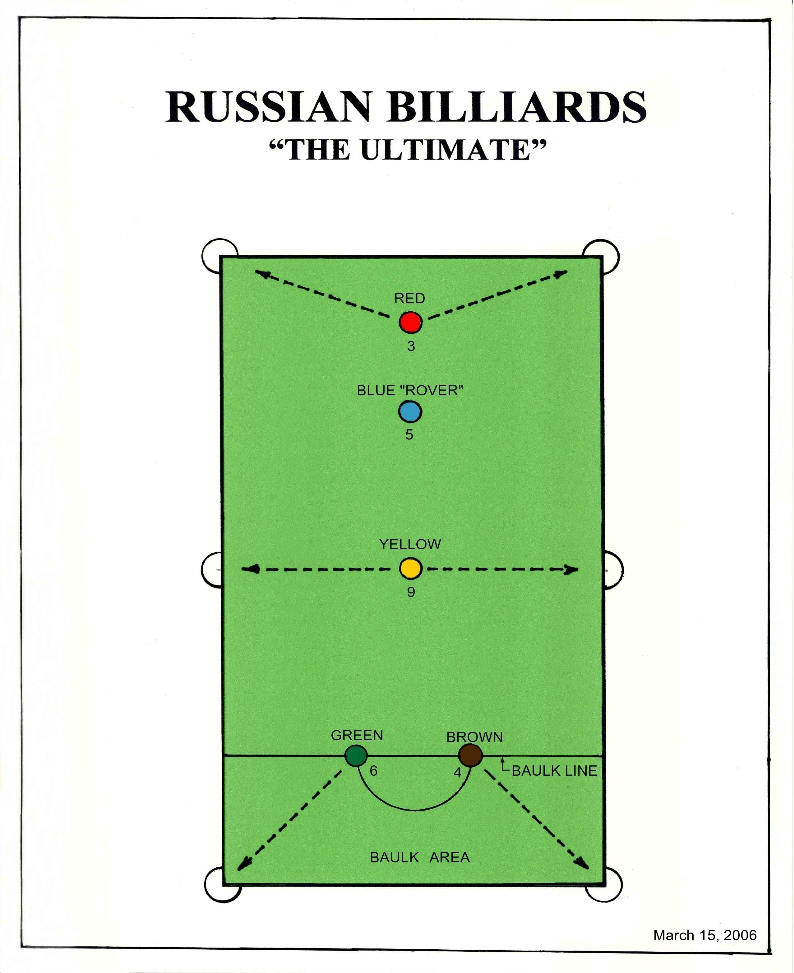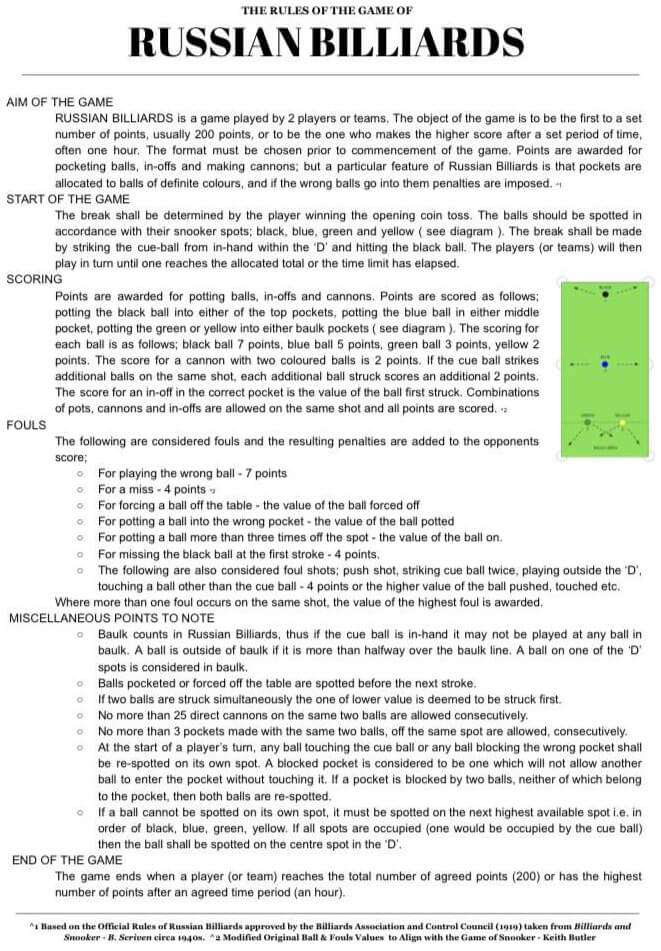Canadian Russian Billiards Rules
The following Canadian version of Russian Billiards is played in Toronto, Ontario, and in Victoria, British Columbia. It is played on a 6' x 12' snooker table using six different colored snooker balls as outlined in the following pages. The game has become popular with snooker players who are having some difficulty maintaining their potting skills. As well, the players experience the joy of having long runs of points from being able to shoot various combinations of cannons, in-offs, or pots. For additional Canadian Russian Billiards information, contact Michael Prescott at: mprescott@shaw.ca
Canadian Russian Billiards Rules
Here is a printable PDF containing the March 2006 Canadian Russian Billiards rules (the same rules listed here).
The Break- The break shall be established by the player winning the opening coin toss.
- The balls shall be spotted on their spots as shown on the diagram with the exception of the blue ball, which shall be kept off the table for the break and positioned on its spot before the next stroke.
- The break shall be made by striking the cue-ball from within or on the line of the "D", and hitting the red ball. There is no penalty for missing the red ball on the break. If the red ball is not struck first on the break, the balls shall be re-spotted (if necessary), and the break taken over.
- The players will play in turn until one player reaches a score of exactly 100 points.
- Points are scored as reflected in the attached diagram and as described in "SCORING" below.
- If a player goes over 100 points during his turn, his score shall immediately return to 50 plus the amount over 100, and the player may continue his turn until a miss or a foul. If a foul should occur on the turn in which 100 points are exceeded, the score shall revert to 50 less the penalty.
- At the start of a turn, any ball touching the cue ball or any ball blocking the wrong pocket shall be spotted in its regular position. A blocked pocket is considered to be one which will not allow another ball to enter the pocket without touching the offending ball. The blue ball may not block a pocket. If a pocket is blocked by two balls, neither of which belong to the pocket, then both balls may be spotted.
- When the cue ball is pocketed, or leaves the table, it must next be played from within or on the line of the "D" and must be played away from the baulk i.e., up the table.
- When playing from within or on the line of the D, the first ball to be struck by the cue ball must be outside of the baulk area. A ball is outside of the baulk area if it is more than halfway over the baulk line. A ball on one of the D spots is considered to be in the baulk area.
- A ball may be potted for a maximum of four consecutive pots i.e., it may be replaced on its spot only three times.
- If a ball cannot be spotted in its regular position it must be spotted on the highest available spot i.e., the first available in the order of yellow, green, blue, brown, or red.
- If all spots are occupied (one would be occupied by the cue ball), then the ball shall be spotted on the centre spot in the D.
- The following are considered fouls: - push shot; - striking the cue ball twice; - playing outside the D when in hand; - touching or moving any ball with rack, clothing, hand, or other part of the body, or (other than the cue ball) with the cue; - sinking any ball in the incorrect pocket; - sinking a ball after it has been spotted three consecutive times; - an in-off into the incorrect pocket; - missing all balls; - knocking any ball off the table.
- The penalty for any foul shall be to forfeit the run and to deduct the penalty points from the player's score at the start of the run. The penalty points are two points except for potting or an in-off in the incorrect pocket. The penalty for a ball in the wrong pocket is the value of the ball incorrectly potted. The penalty for an in-off in the wrong pocket is the value of the ball first struck. The penalty for sinking a ball after it has been spotted three consecutive times is the value of the ball potted. Where more than one foul occurs on the same shot, the value of the highest foul is to be deducted.
- A two point penalty may not be deducted from a player's score if the score is 97 or 99, in which case the penalty shall be added to the opponent's score. The opponent may decline the two points if it would be to his disadvantage e.g., if he had a score of 95, 97, or 99, in which case no penalty would be added or subtracted from either score.
- The score for a cannon (cue ball striking two colored balls) is two points. If the cue ball strikes additional balls on the same shot, each additional ball struck scores an additional two points. Hitting the same ball more than once does not score additional points.
- The score for a pot in the correct pocket as shown by the arrows in the diagram are: yellow 9 points; green 6 points; blue in any pocket 5 points; brown 4 points; and red 3 points.
- The score for an in-off in the correct pocket is the value of the ball first struck.
- Combinations of cannons, pots, and in-offs are allowed on the same shot, and all points shall be scored.
- If a players score is below 100 i.e., 99 or less, a deliberate foul by potting a ball or an in-off in the wrong pocket is allowed to reduce the score, subject to rule 15 above.
How to Rack the Balls in Canadian Russian Billiards Rules
Below is a picture showing the proper way to set up the rack in Canadian Russian Billiards Rules

Canadian Russian Billiards Rules
If you have any questions about Canadian Russian Billiards Rules, please post them in the pool rules forum.
Canadian Russian Billiards Rules History
The Canadian Russian Billiards rules originated in Toronto, ON near the end of the second World War. View the full history of Canadian Russian Billiards as provided by Michael Prescott.
The official Canadian Russian Billiards Rules are predominently observed in Canada (Victoria, BC and Toronto, ON).
How to Play Canadian Russian Billiards
- Title: Canadian Russian Billiards Rules
- Author: mprescott (Michael Prescott)
- Published: 3/15/2006
- Last Updated: 3/15/2017 4:47:02 PM
- Last Updated By: billiardsforum (Billiards Forum)
- Source: Submitted by a Billiards Forum Member
Canadian Russian Billiards Rules
The Canadian Russian Billiards Rules article belongs to the Snooker Rules category. Snooker is a type of cue sport game that is played on a snooker table.
Canadian Russian Billiards Rules Comments
Mike Bannon from London, ON on 4/5/2014 2:37:30 PM
I was looking for the rules for a snooker game we call "Russian", using only the brown, green, yellow and red balls, and I think this is it. Thanks!
The game was popular in Ontario, Canada years ago.
Leonard Ponzie from Montreal, QC on 4/20/2020 5:57:33 AM
We used to play Russian Billiards in Montreal Quebec Canada in 1960 to 1990
The rules were:
- If you made a billiard striking the cue ball with two balls it counted for two points.
- You were allowed to pot any colour in the correct pocket three times on its spot
- If you potted a colour on its spot 4 times you would lose all your points made
- The goal is to make 100 points without going over. The way we played was that if you went over 100 points you would lose all your points and you started over.
George Chenier use to play Russian Billiards in Montreal Quebec at the Mount Royal Snooker Club in 1960.
Hope this helps.
 kab3121 from Birmingham, United Kingdom on 2/21/2025 1:34:05 PM
kab3121 from Birmingham, United Kingdom on 2/21/2025 1:34:05 PMWe play Russian Billiards (pool) at our club in Harborne, England.
We follow the BACC rules circa 1919.
I have amended the rules so that the points awarded are the same as snooker for ease of remembering.
Reply and share your comments below:

